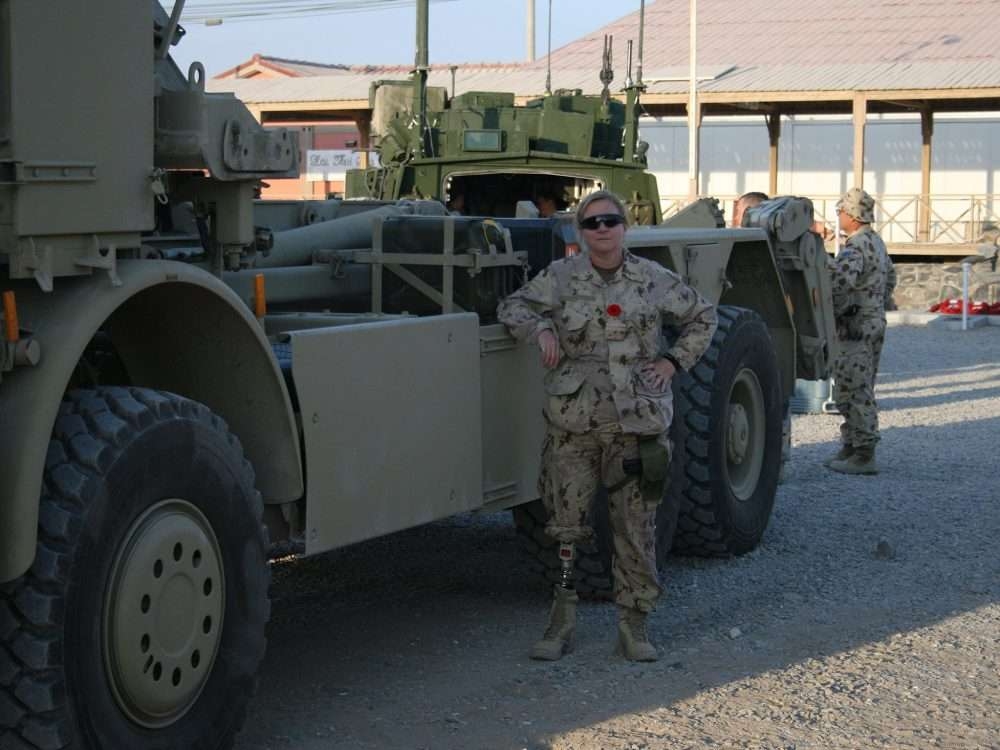
Highly Paid Bureaucrats at Veterans Affairs Good at Taking Care of Themselves – But Not an Amputee
Captain Kimberly Fawcett has given years of service fighting for her country. In 2006, she was involved in a tragic accident which caused her to lose both her nine-month-old son and her right leg in one fell swoop. Since then, she has been fighting against the same government she used to fight for: she is pushing for financial help, but Canada’s military persistently refuses to pay the $34,000 required for a prosthetic limb.
In 2006, Fawcett’s unit was preparing for deployment as the war in Afghanistan was escalating. She had already served in Afghanistan, but this time, things were different. She was now the mother of a nine-month-old baby and had just come back from maternity leave; her husband Curtis, who is also in the military, was preparing to leave for a mission. Both Fawcett and her husband were members of high readiness units, which meant that they could be deployed on short notice but also at the same time. With the possibility of a simultaneous deployment, the Canadian Armed Forces required these new parents to devise a plan, known as the Family Care Plan, to make sure that baby Keiran would always have child care.
It was for that very reason, and with the approval of her commanding officer, that Fawcett executed the Family Care Plan. On the morning of February 21, 2006, she put on her forest green combat uniform and put her son in the car to leave him in the care of his grandparents.
That’s when things took a horrible turn.
As Fawcett merged onto the Highway 401 near Kingston, she almost immediately lost control of her vehicle as it spun on ice, slid across traffic and slammed into the median. Fawcett immediately realized she and Keiran were in danger, as they were stuck blocking the passing lane. She thought it would be safest to take her son and head to the other side of a ditch to wait for help. As she stepped down into the ditch with her son in her arms, a speeding truck lost control and plunged into the ditch, hitting Fawcett’s right side. The truck clipped the side of Fawcett’s leg, and as the button of her combat pant got caught in the grill, she was pulled down abruptly. Both tires ran over her and the motion tore off her right leg. The impact sent Keiran flying from his mother’s arms and into the path of a transport truck. Nothing could have been done. He was killed instantly.
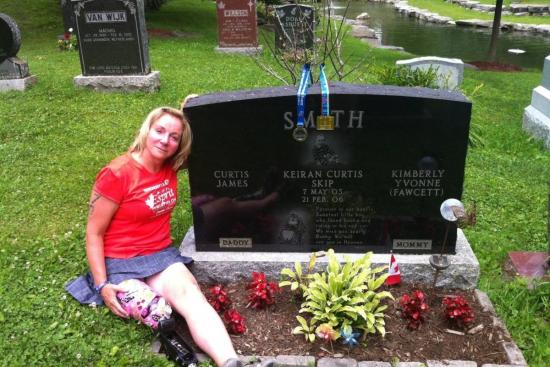
In addition to her missing leg, Fawcett had 21 fractures. Shattered bones all along her right side were hardly held in place by the cloth of her combat coat. Her spine was broken in five different spots, along with her jaw and cheekbone, her remaining foot completely twisted.
When Fawcett woke up in the ICU after being in a coma, special arrangements were made to have Keiran brought to his mother’s bedside in his casket for a final goodbye.
Despite this terrible tragedy, Fawcett fought to overpower the grief from losing her son as well as the pain from her injuries. Six months after she lost her leg, she went back to work and continued to serve in the military—all the while, she was still in and out of surgery. She decided she wanted to return to Afghanistan and she was the first female soldier to serve in the warzone with a prosthetic leg. In 2008, two years after the death of her son, she completed a second tour of duty in Afghanistan, helping families of fallen soldiers to process their own losses. Her rehabilitation brought many challenges, but the results she made each day were remarkable as she found ways to channel her pain into sports. Against all odds, Fawcett learned to swim, bike and run again into paratriathlon. She competed in numerous para-sports events, winning four world medals and climbing to the top of Mount Kilimanjaro—twice.
Though she has done her fair share of fighting—13 years can take a toll on a person—her fight is still not over. Now, she has to fight against the Canadian Forces. Despite her years of dedicated service, Fawcett has been betrayed by the very government she has been serving.
The expenses for her prosthetic and care quickly rose, and by week 15 as her bills really started to pile up, Fawcett applied for military disability benefits. Her claim was flatly rejected by one of her commanding officers on the basis that she wasn’t “on duty” at the time of the accident. At first, she decided to not pursue her claim any further, but the bills weren’t disappearing anytime soon. When she heard about other soldiers with similar injuries who were approved for benefits and disability pensions, she decided to file a grievance in 2009.
After waiting for 2 years, Fawcett’s case was finally opened. Once again, the military’s decision to deny her benefits was maintained. She decided to go to the Federal Court for a judicial review.
The decision to deny her benefits seemed unreasonable for the judge and the case was ordered for re-evaluation. However, in 2015, her claim was once again rejected. She sought the court’s review and again it was sent back for re-evaluation. Still, the military’s assessment did not change, and with much frustration, Fawcett appealed yet again. In 2017, a third Federal Court judge ruled, this time, in the military’s favour.
Fawcett is once more appealing that decision. Up to today, a date for her appeal hearing has yet to be set.
In February 2018, which marks the anniversary of the accident, Fawcett received an envelope marked FINAL NOTICE, with a bill for $34,151.15 from the prosthetic company.
The root of the dispute is the debate on what “on duty” truly means. The military insisted that Fawcett was fulfilling personal obligations as “a mom” and not military duties as “a soldier” at the time of the accident, which was also caused by personal factors.
Fawcett’s rebuttal was that she was required—by military order—to have a Family Care Plan. It was while in uniform, during work hours, and with the approval of her commanding officer that she activated that plan to prepare for her and her husband’s upcoming deployment.
Fawcett alleged that part of the problem stems from the sexist culture in the military towards women. What would be considered “on-duty” for a man is considered as “mom duty” for a woman.
In 2009, a month after filling her first grievance, Chief of Military Personnel and Major-General at the time, Walter Semianiw, wrote a letter to address her case. He disagreed with the Commander officer’s claim and determined that Fawcett was indeed "on-duty" and following military orders, which validated that “the execution of the Family Care Plan is in fact, a military order.”
For over 13 years, the military bureaucracy has been obstinately fighting and contradicting itself. The Fawcett case raises serious questions about the judgment of the Canadian Forces Personnel Command, its senior officers, their training, to act in the best interests of soldiers.
The situation that Fawcett is in, is even more outrageous when compared with the case of Christopher Garnier. In 2015, Garnier was convicted of strangling an off-duty police officer Catherine Campbell, whose body was later found in a compost bin in Halifax. Garnier claims that Campbell’s brutal murder caused him to suffer from Post-Traumatic Stress Disorder (PTSD). He has never served a day of his life in the Canadian Forces, yet because his father is veteran, the treatment that Garnier is receiving in prison is being funded by Veterans Affairs Canada. We need to ask ourselves this question. How is it acceptable that Christopher Garnier was eligible in the eyes of the Veteran Affairs, yet Fawcett, who has proudly served her country is not?
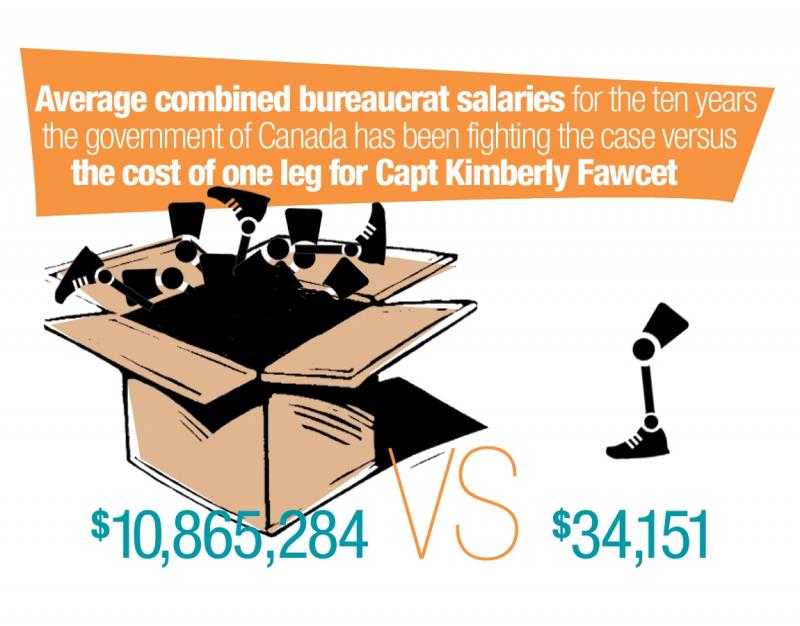
Below is a list of the members of the Veteran Affairs. Of the 11 members, 7 served in the Canadian Armed Forces just like Captain Fawcett did. Collectively, the annual combined taxpayer funded salaries of these "public servants" is in the millions of dollars. Yet, despite their grandiose titles, highly paid salaries and very generous taxpayer-subsidized pensions, they seemed unable to ensure that Captain Fawcett received funds for her prosthetic leg. Worse, they further humiliated her as she struggled to get the help she required and deserved.
Captain Fawcett lived up to her commitment to the Canadian Armed Forces. However, these Veterans Affairs actions have only contributed to making Fawcett’s loss worse.
These highly paid senior bureaucrats are part of the top-heavy executive team responsible for running the Department of Veterans Affairs.
In their bios on the Veterans Affairs of Canada website they all laud their experience, but given their track record one wonders why we pay these people so much.

The Honourable Lawrence MacAulay, Minister of Veterans Affairs and Associate Minister of National Defence
Lawrence MacAulay, Member of Parliament for Carding, was first elected to the House of Commons in 1988 and he was won his ninth consecutive election in 2015. The average salary for this position is $255,300. As a senior cabinet minister, he also benefits from a gold plated pension.

Stéphane Lauzon, Parliamentary Secretary to the Minister of Veterans Affairs and Associate Minister of National Defence
Stéphane Lauzon worked at the Canadian International Paper and after completing a teaching certificate he worked in the field of vocational training for over 20 years. He became a municipal councilor for the City of Gatineau in November 2009. On August 2018, he was appointed as Parliamentary Secretary for the Minister of Veterans Affairs and Associate of National Defence. The average salary for this position is $184,000 per year.
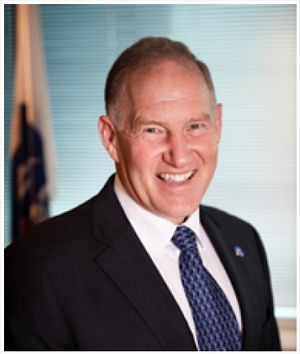
Walt Natynczyk, Deputy Minister General (retired) CMM MSC CD, Canada's former "top soldier".
General Natynczyk joined the Canadian Forces in 1975 after spending five years as an Air Cadet. He served in numerous regimental command positions. He spent years on international missions around the world. He also served as Canada's Chief of Defence Staff from July 2008 to October 2012. Key events over his tenure were the combat mission in Afghanistan, the 2010 Winter Olympics, humanitarian support to Haiti and the NATO mission over Libya. On November 2014, he began his role as Deputy Minister of Veterans Affairs Canada. The average salary for this position ranges from $192,600 to $326,500 a year. He also has a generous military pension.
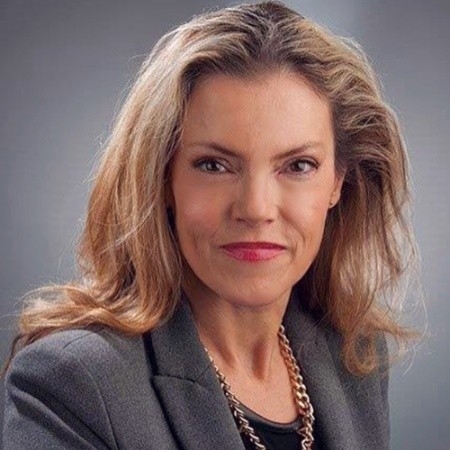
Lisa Campbell, Associate Deputy Minister
Previously, Lisa Campbell was Assistant Deputy Minister, Defence and Marine Procurement, Public Services and Procurement, leading the organization providing military and marine procurement solutions for Canada. She now works as the Associate Deputy Minister, Veterans Affairs Canada. The average salary for this position ranges from $190,000 to $230,000 per year.
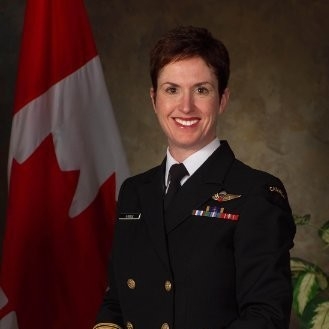
Elizabeth Stuart, Assistant Deputy Minister, Human Resources and Corporate Services
Rear-Admiral (Ret’d) Elizabeth Stuart started as a reservist in 1983 and transferred to the Regular Force in 1986 in the Sea Logistics Officer career path. Following her retirement from the Canadian Armed Forces in 2016, she was appointed as Assistant Deputy Minister, Human Resources and Corporate Services. The average salary for this position is $155,396 per year.

Charlotte Bastien, Assistant Deputy Minister, Strategic Oversight and Communications
Mrs. Charlotte Bastien started her federal Public Service career in 1988 at the Department of Environment Canada where she has held a number of varied positions at the regional and national levels. Mrs. Bastien joined the Department of Veterans Affairs Canada (VAC) in July 2003 as the Associate Regional Director General, Quebec Region. Mrs. Bastien was Director-General, Field Operations for Veterans Affairs Canada since April 2013. The average salary for this position is $155,396 per year.

Michel Doiron, Assistant Deputy Minister, Service Delivery
Michel Doiron began his career in Public Service in and after progressing through various management positions he joined Veterans Affairs in 2013. As the Assistant Deputy Minister, for Service Delivery he is responsible for providing direct service to Veterans, Canadian Armed Forces members, RCMP members, certain civilians, and their families.
The average salary for this position is $155,396 per year.

Bernard Butler, Assistant Deputy Minister, Strategic Policy and Commemoration
Bernard Butler began his career in the federal public service as a lawyer with the Bureau of Pensions Advocates. He is currently Assistant Deputy Minister of Strategic Policy and Commemoration at Veterans Affairs Canada (VAC). The average salary for this position is $155,396 per year.
The following members are not part of the Veterans Affairs, but their current position as members of National Defence or the Government means that their voice has an impact on Veterans affairs. Furthermore they have all, at one point in their career, served in the Canadian Armed Forces, but still, they haven’t done much to help Captain Fawcett.
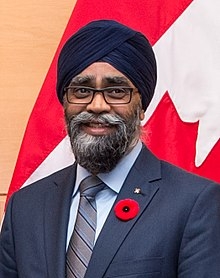
The Honourable Harjit Singh Sajjan, Minister of National Defence
Harjit Singh Sajjan has served Canada and his community as both a soldier and a police officer and is a retired Lieutenant-Colonel in the Canadian Armed Forces and a combat veteran. He was deployed to Bosnia-Herzegovina and served three separate deployments to Kandahar, Afghanistan. Harjit was a police officer with the Vancouver Police Department for 11 years. He was appointed as Minister of National Defence in November 2015. The average salary for this position is $255,300 per year.
As not only the Minister of National Defence but also as the previous acting Minister of Veterans Affair, Harjit has done nothing to make progress in Fawcett’s case. Furthermore, during the House of Common on December 13th, Conservative MP Erin O’Toole confronted Harjit, who assured in the past that he would never let a Veteran go to court to fight for benefits. Harjit seemed indignant when faced with the accusations, but still, the reality remains that nothing has been done to help Captain Fawcett.
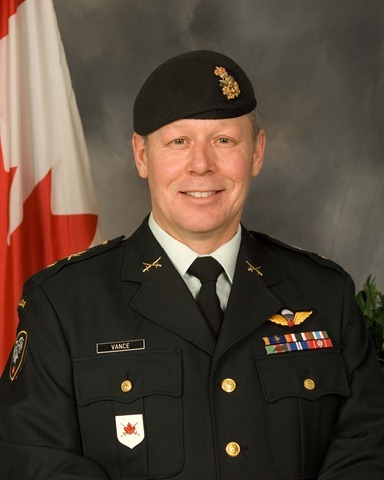
General Jonathan Vance, Canadian Armed Forces Chief of the Defence
General Jonathan Vance joined the Canadian Armed Forces in 1982. He served in Canada, Germany and on UN Peacekeeping operations and has commanded at all levels within the field force from platoon commander to brigade commander and in combat operations as a Joint Task Force Commander, and also did tours in Afghanistan. General Vance was promoted to his current rank and formally appointed as the Canadian Armed Forces Chief of the Defence Staff in July 2015. As Chief of the Defence, General Vance. The salary for this position is between $247,900 to $291,600 per year.
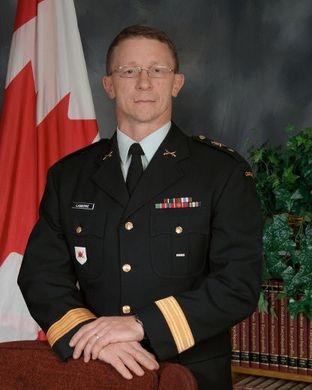
Charles Lamarre, Lieutenant-General
Lieutenant-General Lamarre joined the Canadian Forces in June 1981. During his career, he has commanded at the Platoon, Company, Battalion and Formation level. His most recent operational tour was as Commander, Mission Transition Task Force, as part of the Joint Task Force Afghanistan. Other operational tours include Croatia and Bosnia, and Afghanistan. In March 2017, he was promoted to the rank of Lieutenant-General and designated as the Commander, Military Personnel Command. The average salary for this position is $248,196 per year.
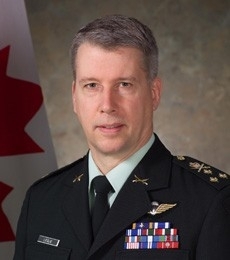
Andrew Leslie, MP Parliamentary Secretary to the Minister of Foreign Affairs
Andrew Leslie worked with the Canadian Armed Forces for 35-year. His career has included a variety of command and staff positions in numerous overseas postings with the UN and NATO. Mr. Leslie retired in 2011 and was elected as Member of Parliament for Orléans in October 2015. He served as Chief Government Whip from November 2015 to January 2017 and is currently Parliamentary Secretary to the Minister of Foreign Affairs. Still, as a former member of the military, The average salary for this position is $184,000 per year.
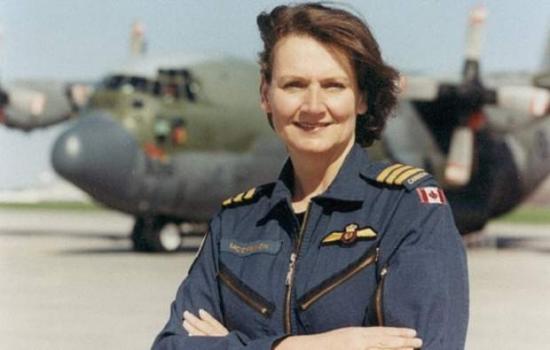
Karen McCrimmon, MP Parliamentary Secretary to the Minister of Public Safety and Emergency Preparedness
Karen McCrimmon joined the Canadian Forces as a reservist and then transferred to the Regular Forces. In 1981, she became an air navigator. In 1998, Ms. McCrimmon was promoted to Lieutenant-Colonel and appointed Commanding Officer of 429 Transport Squadron in Trenton. She retired from the Canadian Forces in 2006. She has served as a Parliamentary Secretary since 2015 and is currently the Parliamentary Secretary to the Minister of Public Safety and Emergency Preparedness. The average salary for this position is $184,000 per year.
As former members of the military, both Andrew Leslie and Karen McCrimmon benefit from a military pension. Now as Members of Parliament there are no records of achievement and they have been very silent in helping veterans.








